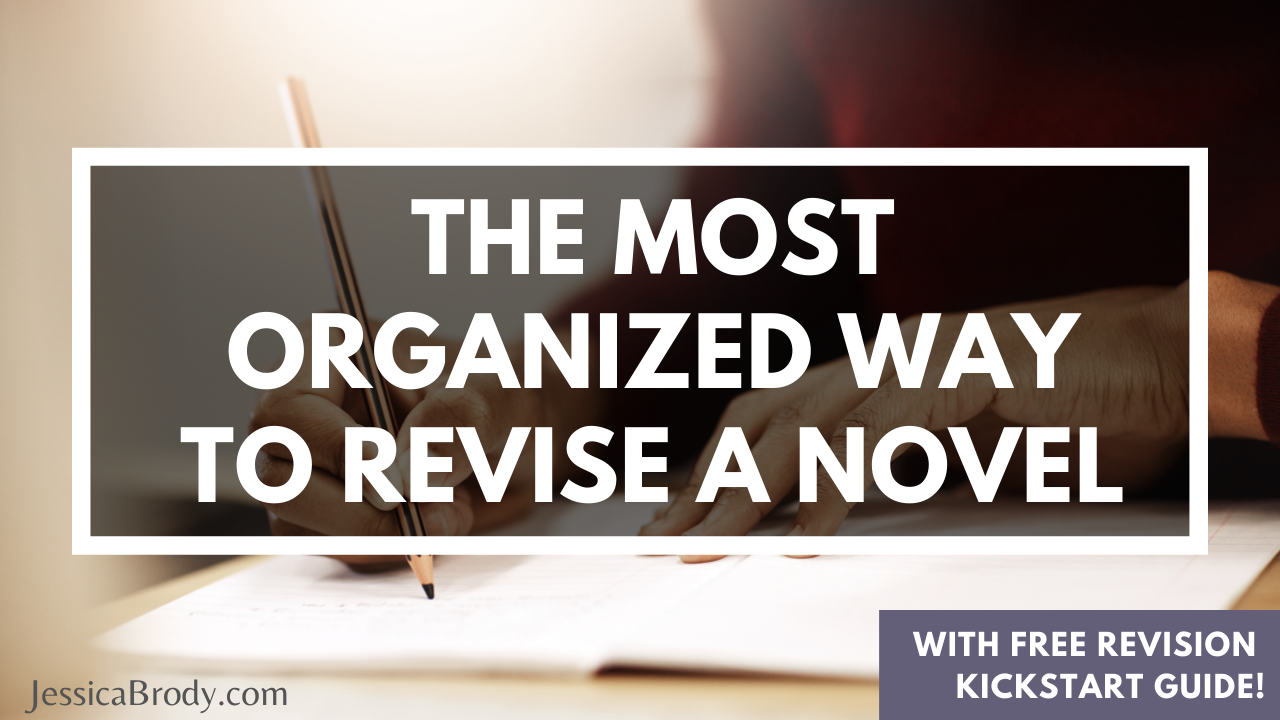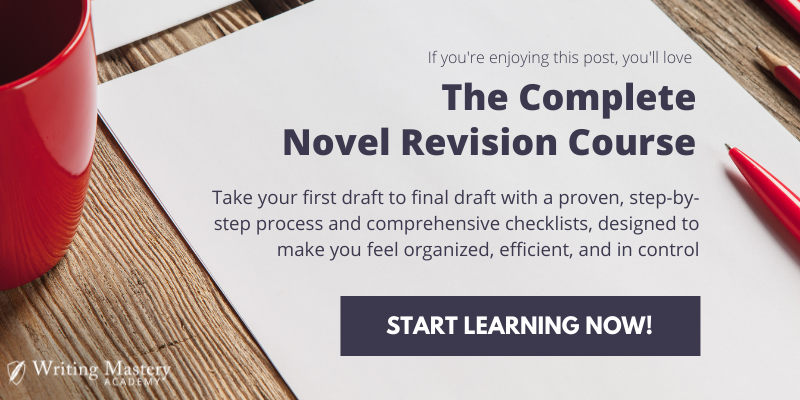The Most Organized Way to Revise a Novel (+ Free Revision Kickstart Guide)

So, you’ve written a first draft of a novel. Now what?
If you’re like most writers, the thought of revising your first draft (especially if it’s a messy one) is so daunting, you’re afraid to even begin. Sadly, many authors finish a first draft and then tuck it in the proverbial drawer never to be seen again, because they’re just too overwhelmed by the idea of making it work. They’re plagued by questions like:
What do I focus on?
How do I keep myself organized?
Where do I start?
Well, say goodbye to revision overwhelm and fatigue and say hello to the most organized and efficient method for revising a novel.
This method–which I call the “Level Down Revision Method”–was developed from my own experience revising more than 20 novels with major publishers. It’s modeled after the process professional editors use to guide authors through their revisions.
And it’s a game changer.
This method has saved me thousands of hours of time, rewrites, and wasted effort and anxiety. It breaks the revision process down into manageable steps to ensure you’re always doing the right task at the right time and avoiding any superfluous work.
It’s specifically designed to make you feel organized, confident, and in control of the revision process. (And if you’ve ever tried to revise a novel before, you know how easy it is to feel disorganized, insecure, and completely out of control.)
In this post, I’ll introduce you to the Level-Down Revision Method, show you how it works, and how it will put you on the fast track to novel revision success!
If you want to dig deeper into the method (including a step-by-step guide on how to get started using it), be sure to download my FREE Level-Down Revision Kickstart Guide or check out my Complete Novel Revision online course.
To fully understand the benefits of the Level-Down Revision Method, we first need to take a look at the other revision method. The one that leaves you feeling overwhelmed, disorganized, and unfocused. (I know this method well because it’s how I used to revise my novels, before I developed my current method.)
The Least Efficient Way to Revise Your Novel
Turn to page 1 and start revising.
That’s it.
Seems simple enough, right? Seems logical even. I wrote the book in order (or most of us do), why not revise it in order?
But actually, this is the least efficient way to revise a novel. And unfortunately, the way that most authors do revise their novels.
Here’s the problem with revising a novel this way.
It means you’re attempting to rewrite scenes, fix character development, restructure the plot, add subplots, delete subplots, polish clunky sentences, add conflict, ratchet up tension, flesh out worldbuilding, fix inconsistencies, find the perfect word to describe the sky on page 245…
ALL AT THE SAME TIME!
If just reading that paragraph made you feel overwhelmed, try actually doing it!
It’s no wonder so many authors give up on their novel revision! It’s just too much to handle all at once!
Trying to revise your novel this way is sure to leave you feeling:
- Disorganized – Because it’s difficult to track your goals, your tasks, and your progress, which in turn makes it difficult to hold yourself accountable
- Inefficient – Because you’re bound to do way more work than you need to
- Unfocused – Because when you’re trying to do so many different types of revision tasks at once, it’s hard to do any one of those tasks well
- Overwhelmed – Because it’s impossible to hold ALL of those tasks (and the ripple effects they’ll surely have in the story) in your head at once
As you move through the manuscript and find more things to fix, you’ll find yourself doubling back (again and again) to revise what you’ve already revised, which can make the revision process feel never-ending!
Again, I know all of this because I used to do it this way. And it was very stressful.
Then, I developed the Level-Down Revision Method and it changed everything. So, let me walk you through how it works.
The Most Efficient Way to Revise Your Novel
The Level-Down Revision Method essentially breaks your revision into multiple levels or “passes” through the manuscript.
It starts with a macro-level view of your story and works down to a micro-level view of your story, allowing you to focus on one level (or type of revision task) at a time.
Which provides you with a structured and organized method for tackling a revision.
And it looks like this:

The Three Levels
Here’s an overview of the three levels and what you should be focusing on in each.
The Story-Level Revision
The first revision level is the Story-Level revision (also called the “Developmental Edit”) This is where you focus on bigger picture items that affect the entire story, like structure, plot, character arcs, character development, worldbuilding and the overall pacing of the plot.
This is by far the most extensive level of the revision process where you will probably spend most of your revision time. But it’s important to spend the time here to nail down that overall story, because having a well-structured story automatically makes the next levels of the revision process easier and more streamlined.
The Scene-Level Revision
Once you have your story firmly in place, you can move on to the Scene-Level revision (also called the “Detailed Edit”), tackling the novel in smaller pieces and ensuring that each scene (or event in the plot) is crafted effectively.
This is the “medium-level” view where you revise each scene as though it’s its own mini-story, focusing on scene pacing, scene structure, and essential scene elements.
The Page-Level Revision
And finally, the last revision level is the Page-Level revision (also called the “Line Edit”) where you revise each page, line by line, making sure your writing is dynamic and compelling on every page. All the nitty gritty editing work is done at this level where you focus on polishing sentences, word choice, syntax, and more line-editing work. This is the most zoomed-in revision level.
Why the Level-Down Revision Method Works
Breaking the revision process down into these three levels allows you to concentrate on one aspect of the revision at a time, which is much more effective and efficient than trying to do it all at once.
It also ensures you aren’t doing any superfluous work (like spending hours revising a single paragraph just to have it be cut the next day when you realize it doesn’t fit into the current plot or doesn’t serve the character’s story arc. Or spending two days revising a single scene only to discover it needs to be moved to an entirely different place in the story and you have to start over.)
Revising your novel using the Level-Down Revision Method makes you feel:
- Organized – Because it breaks the process down into achievable steps and gives you trackable goals to work toward.
- Efficient – Because it ensures you don’t do a ton of superfluous work.
- Focused – Because it allows you to dedicate all of your efforts to one type of task at a time, which makes it easier to hold the necessary story parts in your head when you’re working on them.
- Empowered – Because it makes you feel confident you’re doing the right task at the right time, which keeps revisions “doable” and “controllable.”
And the best part is, instead of feeling like the revision is never-ending, you get to complete each level of the process with a sense of “victory!” A milestone achieved!

How to Organize Your Revision Into Levels
Now that you understand the revision levels, you can start organizing your revision notes and ideas into these levels and tackling them at the right time in the process.
You’ll want to work through your revision list and notes one by one and categorize them as “Story-Level,” “Scene-Level” or “Page-Level.”
The goal here is to figure out what you need to do next and what can wait for a future level or draft. In other words, you don’t want to start tearing apart scenes (Scene-Level) or fixing sentences (Page-Level) before you get your story structure figured out (Story-Level) as it will only lead to wasted time and energy.
The quickest way to determine if an idea or revision task is Story-Level, Scene-Level, or Page-Level is to ask yourself the following questions:
Does this idea affect the entire story (or multiple scenes/chapters?)
If yes, then it goes in the Story-Level Revision.
Does this idea affect only this scene/chapter?
If yes, then it goes in the Scene-Level Revision.
Does this idea affect only this page or paragraph?
If yes, then it goes in the Page-Level Revision.
For example:
Do you need to introduce the love interest sooner?
That will probably affect more than just one scene as moving characters around tends to have ripple effects throughout the story. So it’s a Story-Level revision.
Do you need to add more conflict to a big fight scene?
This is probably referring to a single scene in which the fight takes place, which means the changes made here probably won’t affect too many other scenes in the story (if any). This goes in the Scene-Level revision.
Do you need to rewrite the description of a specific building?
As long as the description doesn’t affect every scene that the building is in, this is a Page-Level revision. If, however, the task requires more world building in general and that world building will ripple through the rest of the story, it would be a Story-Level revision.
So, there you have it! My Level-Down Revision Method, your key to a successful, organized, efficient revision process.
If you need help analyzing your story and deciding what tasks you should be doing in each level, my Complete Novel Revision Course comes with complete checklists for each revision level that you can use to self-diagnosis your own manuscript, revise common story-level, scene-level, and page-level issues, and confidently determine when you’re ready to move to the next revision level.
I also walk through the entire process with my own project and revise a novel right along with you, including storyboard demos, scene-card demos, and even live line-editing demos!
Happy Revising!
Filed under: Tips for Writers Writing Mastery Tagged with: fiction writing novel revision novel writing Revision Kickstart (LMAP) revision tips revisions save the cat Tips for Writers writing mastery writing tips